|
THE JAMES
BOND COMIC STRIP
Daily Express Series 1 (1958-1962) Drawn by John McLusky
WRITTEN &
COMPILED BY GRAHAM RYE & KEVIN HARPER |
|
|
In 1956 leading UK newspaper the Daily Express had begun to
serialize abridged versions of
Ian Fleming's James Bond novels in weekday instalments to coincide
with their
hardback
publication. Adapted by
staff writer Anthony Hern, DIAMONDS ARE FOREVER was the first novel
to be serialized, and ran for eleven days from Thursday April 12 -
Tuesday April 24, 1956. The serialization was accompanied by stylish
drawings by Andrew Robb (1907-1989), who would continue to illustrate
all remaining adaptations with the exception of GOLDFINGER, the short
story RISICO (under the title The Double-Take), and
THUNDERBALL, which were visualised by graphic designers Raymond Hawkey
& Michael Rand,
and photographer Kenneth Denyer. Although Hawkey & Denyer did use an
unidentified stand-in as Bond, Robb only occasionally showed the
face of Ian Fleming's hero in his illustrations. However, all this was
about to change when in 1958 the
Daily Express approached Ian Fleming with the idea of turning his
James Bond novels into a comic strip. Fleming was in two minds about the
whole project and consulted his close friend
William Plomer
(1903-1973). Despite Plomer’s opinion that it would be a grave error
to accept the Express offer, Fleming chose to ignore his
friend’s advice on this occasion. The Daily Express was
offering a minimum payment of £1,500 per book, and with the
possibility of a share in the syndication rights, Fleming could hardly
have ignored this chance of a lifetime. Daily Express editor
Edward Pickering (1912-2003) guaranteed the author that the transition
of Bond into a strip character would be handled as a ‘Rolls-Royce
job’. The man chosen to adapt the stories into a daily comic strip was
Daily
Express literary editor Anthony Hern, who was still providing
the abridged text for the adaptations of Ian Fleming's novels in the
newspaper. After seeing a proof of the first instalment of Hern's
adaptation of DIAMONDS ARE FOREVER, Ian Fleming's sent a telegram to
the writer which simply read: ‘SALUTE TO A MASTER BUTCHER’. |
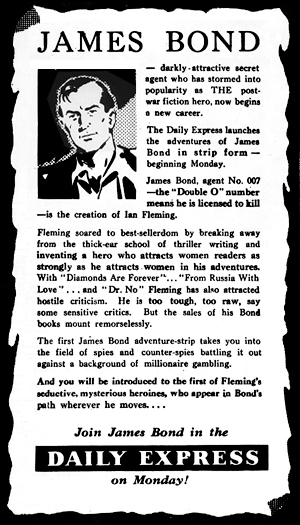 |
|
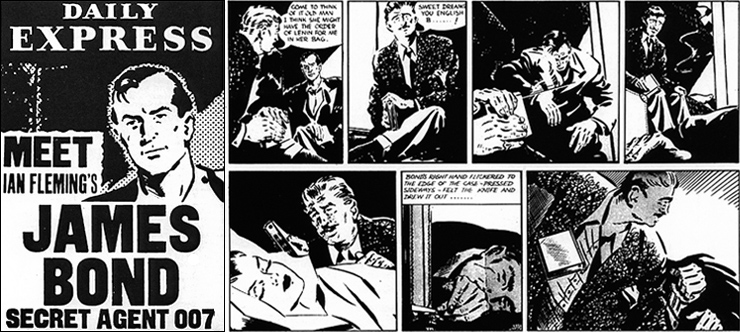 |
|
The talents of 35-year
old John McLusky (1923-2006) were engaged to illustrate the comic strip.
But before he was put under contract for CASINO ROYALE, McLusky was asked
to draw the ‘book-gun’ sequence in FROM RUSSIA, WITH LOVE for Ian
Fleming's approval [pictured above right]. The author had provided a
drawing by another artist of what he thought James Bond should look like,
but when McLusky created Bond's facial characteristics he remembered Ian
Fleming's sporting hero golfer Henry Cotton (1907-1987); together with the
faces of contemporary movie actors such as Robert Taylor (1911-1969), Gary
Cooper (1901-1961), and a dash of the Duke of Edinburgh (1921-2021) -
after all James Bond was a naval commander! James Bond's face from the
unpublished ‘book-gun’ sequence was later used on Daily Express
billboards [pictured above left] to advertise the new strip outside newsagents the
length and breadth of the British Isles.
The James Bond comic strip made its debut in the Daily Express on
Monday July 7, 1958 accompanied by an introduction by Ian Fleming's friend
the acclaimed American crime novelist Raymond Chandler (1888-1959). The
title strip introduced the three main characters and featured a croupier
who looked suspiciously like Ian Fleming! CASINO ROYALE stayed relatively
close to Ian Fleming's original, although several sequences were toned down
for a more general audience. CASINO ROYALE is unique in that it does not
have the rectangular credit panel in the top left-hand corner of each
strip, instead the credits appear in a block above the artwork. After the
23-week adaptation of CASINO ROYALE the Daily Express saw a marked
increase in sales of their broadsheet newspaper. |
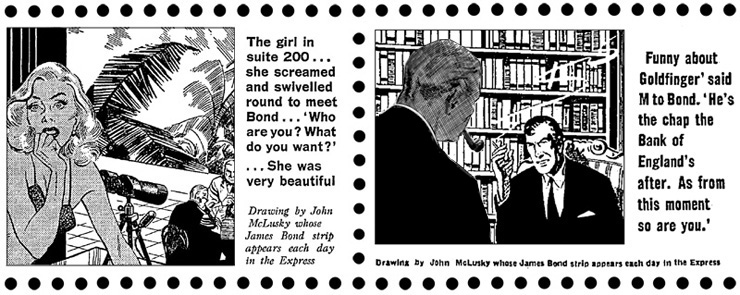 |
|
ABOVE: (left) John
McLusky provided a unique illustration to accompany the first
instalment of the Daily Express serialization of GOLDFINGER
printed on Wednesday March 18, 1959. The drawing shows the
introduction of Jill Masterton as she helps Auric Goldfinger cheat at
Canasta. (right) A second drawing was published on Thursday March
19, 1959 and is actually the complete artwork from the first panel
of strip #236 of MOONRAKER, although with text relating to
GOLDFINGER. John McLusky would usually complete strips a few weeks
ahead of their publication date, and this drawing of Bond in M's
office was repurposed for the GOLDFINGER serialization. In the
published version of strip
#236 from MOONRAKER printed on Friday April 10, 1959 speech bubbles cover up the smoke from Bond's cigarette
as he discusses Hugo Drax with M. |
|
|
|
Starting on Monday
December 15, 1958, LIVE AND LET DIE was the first of eleven stories to
be adapted by Henry Gammidge (1915-1981), who partnered John McLusky on all
subsequent strips in series one and two, with the exception of DR. NO,
which was adapted by Modesty Blaise
creator Peter O'Donnell (1920-2010). The Daily Express strip
ran uninterrupted each weekday for almost four years, with stories
appearing in the same order as their original Jonathan Cape UK hardback publication.
As well as drawing
the daily comic strip for LIVE AND LET DIE, John McLusky also provided
two unique and rarely-seen illustrations [pictured above] printed on
Wednesday 18 & Thursday March 19, 1959 as part of the Daily
Express serialization of Ian Fleming's GOLDFINGER. The 11-part
serialization of the seventh James Bond novel was adapted by Anthony
Hern, and featured stylized illustrations by Raymond Hawkey, who had
recently joined the Daily Express as design director. Hawkey,
along with graphic designer Michael Rand, would revolutionise the use
of illustrations to accompany stories published in the Daily
Express. Michael Rand joined the rival Sunday Times in
1962, and would serve as design director on the colour supplement from
1963-1993.
John McLusky also
provided an illustration [pictured right] to accompany an advertisement
for the Daily Express comic strip which appeared in the
Goldfinger World Premiere brochure in 1964. |
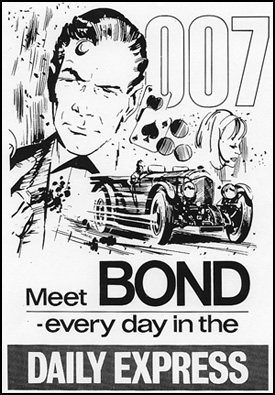 |
|
|
Early stories started
with an introductory strip containing no story narrative, and usually
showed the novel title in the same typeface as seen on the Jonathan Cape
hardcover first edition. Starting with DR. NO, story narrative was
included from the first panel of each new adventure, but reverted back to
an illustrated introductory strip for the final three stories of the first
series. When the James Bond comic strip later went into international
syndication, the title strips were often omitted when they contained no
actual story material. In the case of GOLDFINGER, a revised title strip
was created for the syndicated version omitting the reference to Bond's
farewell to Honey Rider at Miami airport. As most stories were published
out of sequence when the strip went into syndication, any reference to an
earlier adventure was removed. Strips were frequently reformatted and
translated into other languages for syndication. Several strips featuring
implied female nudity (although very tame compared to modern standards)
were also omitted from syndicated stories. The James Bond comic strip went
into worldwide syndication from 1960 and continued to be offered for
publication until July 2021, when the strip was appearing in a colourized Spanish language version in
some Latin American newspapers. On September
26, 2021 the strip made a return to the Sunday Express with a
reprint of the first James Bond story CASINO ROYALE - 63 years after
its original publication. The title strips pictured
in this article are how they originally
appeared in the Daily Express. Additional ‘A-strips’ are also
illustrated when they uniquely appear in either the English or Scottish editions of
the Daily Express. Other anomalies in stories brought about by
printing errors or industrial action are also illustrated in context. |
|
CASINO ROYALE by Ian
Fleming adapted by Anthony Hern
Monday July 7 to Saturday December 13, 1958 - Strip #1-#138 (23-weeks) |
|
|
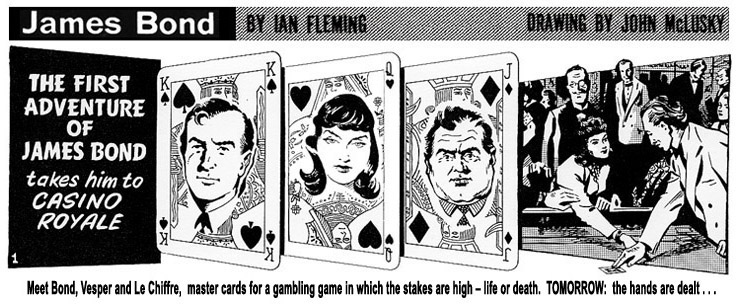 |
|
LIVE AND LET DIE by Ian
Fleming adapted by Henry Gammidge
Monday December 15, 1958 to Saturday March 28, 1959 - Strip #139-#225
(15-weeks) |
|
 |
|
MOONRAKER by Ian
Fleming adapted by Henry Gammidge
Monday March 30 to Saturday August 8, 1959 - Strip #226-#339 (19-weeks) |
|
 |
|
DIAMONDS ARE FOREVER by
Ian Fleming adapted by Henry Gammidge
Monday August 10, 1959 to Saturday January 30, 1960 - Strip #340-#487
(25-weeks) |
|
 |
|
FROM RUSSIA, WITH LOVE
by Ian Fleming adapted by Henry Gammidge
Monday February 1 to Saturday May 21, 1960 - Strip #488-#583 (16-weeks)* |
|
 |
|
*The original Daily
Express presentation of FROM RUSSIA, WITH LOVE is unique in that strip
#572 which should have appeared on Tuesday May 10, 1960 was omitted from
the storyline. This strip was also missing from the first appearance of
the story in the USA, when printed in the Indianapolis News in
1961. Strip #572 was later reinstated into the wider US syndication in
1964, and is present in all subsequent collected versions of FROM RUSSIA,
WITH LOVE. |
 |
|
FROM RUSSIA, WITH LOVE
was the first story of the James Bond comic strip to be affected by a
Public Holiday in the United Kingdom. No newspapers were printed in
England and Wales on Good Friday April 15, 1960 - the day strip #552
should have appeared. Although the Daily Express was published in
Scotland on Good Friday, the comic strip block was not included and #552 then appeared sequentially (with no
loss of narrative) in all editions of the Daily Express on Saturday
April 16th. Ian Fleming's short story RISICO was also being serialized by
the Daily Express during this week and was similarly affected. As
Scottish editions of the Express were printed on Good Friday, the
final part of RISICO (under the title The Double-Take) did appear,
accompanied by an illustration by Raymond Hawkey & Kenneth Denyer. The
concluding instalment of The Double-Take was then printed in the
English edition of the Daily Express on Saturday April 16th, but in
a slightly amended format, but without the Hawkey/Denyer illustration. The
omission of strip #572 [pictured above] from all editions of the Daily
Express in April 1960 was due to Easter affecting the publication
schedule of the newspaper, rather than the strip being dropped due to
contentious material, as would later happen in some syndicated stories in
the USA. Although John McLusky had already provided the numbered artwork
ahead of publication, the inclusion of another individual strip would
affect the overall timing of FROM RUSSIA, WITH LOVE - resulting in the
story ending one day later than scheduled. This omission did not
significantly affect the narrative as the text merely recaps the story at
that point. It was not until 1968 when industrial strike action seriously
affected the publication THE SPY WHO LOVED ME that stories ceased their
Monday start and Saturday end dates. Starting with the comic strip adaptation of
GOLDFINGER in 1961, the Daily Express planned ahead around Public Holidays,
and instructed John McLusky to create unique ‘A-strips’ that were inserted
into the story in different editions of the newspaper to keep the timeline
in synch across the United Kingdom. |
|
DR. NO by Ian Fleming
adapted by Peter O'Donnell
Monday May 23 to Saturday October 1, 1960 - Strip #584-#697 (19-weeks) |
|
 |
|
GOLDFINGER by Ian
Fleming adapted by Henry Gammidge
Monday October 3, 1960 to Saturday April 1, 1961 - Strip #698-#849
(26-weeks)* |
|
 |
|
*GOLDFINGER
as it appeared in the Daily Express is significantly different to
the later syndicated and collected versions of the story. As the strips were often published
out of order in other countries, any reference to another story was
removed. FROM RUSSIA, WITH LOVE also had strip #489 featuring Tiffany Case
removed in some syndicated publications, as this linked it to the previous
story DIAMONDS ARE FOREVER. For the syndicated version of
GOLDFINGER strip #699 was omitted completely and a
new composite title
strip created by merging artwork of Oddjob and Goldfinger from the
original strip #698, and removing the first panel from strip #700. Many of
the strips detailing Goldfinger's planning and raid on Fort Knox also have
different captions to the original Daily Express versions; with
others censored to remove Oddjob attacking Bond with a knife, and some
with alternate artwork. Some
syndicated and later collected foreign language versions of GOLDFINGER did print the original
Daily Express version but with the text translated as required.
Pictured below are strips #699 & #700 as they originally appeared in the
Daily Express version of GOLDFINGER. |
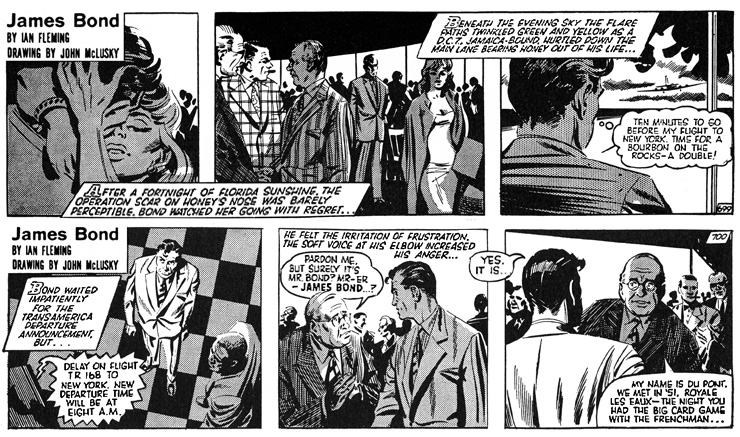 |
|
The original presentation
of GOLDFINGER also included an additional strip drawn by John McLusky. #773A
[pictured below] was published in the English
edition of the Daily Express on Monday January 2, 1961. As this day
was a public holiday in Scotland no newspapers were printed. In order
to keep the story in synch, this additional strip only
appeared in the English edition and does not affect the storyline. |
 |
|
A
further strip #819A was later inserted into
the syndicated version of GOLDFINGER to compensate for the loss of several
panels at the start of the story due to the removal of Honey Rider from the
narrative, and truncation of the first three strips. Strip #819A did not appear
in the Daily Express and is merely a recap of the story so far adding no
new information. |
|
RISICO
short story
by Ian Fleming adapted by Henry Gammidge
Monday April 3 to Saturday June 24, 1961 - Strip #850-#921 (12-weeks) |
|
 |
|
FROM A VIEW TO A KILL
short story
by Ian Fleming adapted by Henry Gammidge
Monday June 26 to Saturday September 9, 1961 - Strip #922-#987 (11-weeks) |
|
 |
|
FOR YOUR EYES ONLY
short story
by Ian Fleming adapted by
Henry Gammidge
Monday September 11 to Saturday December 9, 1961 - Strip #988-#1065
(13-weeks) |
|
 |
|
THUNDERBALL
by Ian Fleming adapted by Henry Gammidge
Monday December 11, 1961 to Saturday February 10, 1962 - Strip #1066-#1117
(9-weeks)* |
|
 |
|
*THUNDERBALL had the
unfortunate distinction of running for only nine weeks when it was
stopped abruptly due to a dispute between Lord Beaverbrook
[William Maxwell Aitken (1879-1964)] - who owned the Daily Express at that time
- and Ian Fleming. Lord Thomson’s Sunday Times launched its
colour magazine on February 4, 1962 which featured the debut of Ian Fleming's 007 short story
THE LIVING DAYLIGHTS. Beaverbrook held newspaper rights for Ian Fleming's
Bond novels, but apparently not the short stories. Although THUNDERBALL
had already begun as a comic strip it was ordered to finish forthwith, and
readers were astonished to find three-quarters of an extremely complicated
plot dismissed in eight lines of text on the composite strip #1117
published on Saturday February 10, 1962. The notoriously mercurial
Beaverbrook interpreted Fleming’s sale of his short story to The
Sunday Times as disloyalty, and felt the Express should
have exclusive rights to Fleming’s work, as not only were they
running Bond in strip format, but had also been serializing his
novels since 1956. |
 |
|
Artist
John McLusky had actually drawn six further strips at the point at the
story ended in the Daily Express, continuing Giuseppe Petacchi's
hijack of the R.A.F. Vindicator Bomber with its nuclear payload. For the
syndicated version of THUNDERBALL these strips (#1117-#1122) were hastily
redrawn by John McLusky, with a new sequence in M’s office that explains
how Bond ended up in The Bahamas where he meets up with CIA agent Felix
Leiter. Many of these panels were made up from strips already drawn by
John McLusky for earlier stories in the series. As the artist had his work
eventually returned to him many years after its publication, the original
full-sized strips (14cm X 47cm) were easily cut out and he pasted elements
to create these new less-detailed composite versions. John McLusky
continued to revise some of his returned strips to his own satisfaction
for the rest of his life, although they were never again published in this
format. He would
frequently re-draw James Bond in panels
from the early stories, so that his facial features now resembled the
version seen in ON HER MAJESTY'S SECRET SERVICE and YOU ONLY LIVE TWICE.
New artwork would be pasted over sections of the original panels, and
several of these ad hoc revised strips were subsequently sold by his estate following
the artist's death
in 2006.
A further six strips were also drawn by John McLusky for the syndicated
version of THUNDERBALL which effectively
illustrate the explanatory text on the composite strip #1117 [pictured
above and seen only in the original Daily Express version in
English]. These six strips
conclude the story and explain how Bond finds the missing bombs, briefly
battles Largo underwater, and ends up in a Nassau hospital where Felix Leiter fills in the gaps.
Some syndicated foreign language versions of THUNDERBALL substituted these
new versions of strips #1117-#1122 with those originally drawn for the Daily
Express, but not published; whilst others continued the hijacking
scene as it was originally intended, and tacked on the six explanatory
strips at the end. It is this version of THUNDERBALL that appears in the
Titan Books anthology editions. Consequently, there are two sets of strips
labelled #1117-#1122, and therefore no definitive English language
version of the story. The syndicated version of THUNDERBALL also
includes an additional strip #1081A not published in the Daily Express,
and presumably inserted into the narrative to compensate for the loss of
the unique concluding strip #1117 which only appeared in the
Express, and some early foreign language syndicated versions of
THUNDERBALL. The title lettering is also different on the
opening strip of the syndicated
version of THUNDERBALL, and an alternate illustration of Ernst Stavro
Blofeld is seen pushing the detonator button. The world map is also
simplified for the syndicated version of the strip. |
|
THE
JAMES BOND COMIC STRIP
Daily Express Series 2 (1964-1966) Drawn by John McLusky |
|
 |
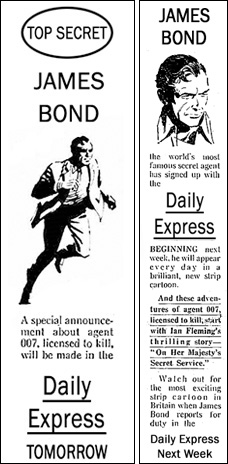 |
It was not until Monday June 29, 1964 -
just three weeks after the death of Lord Beaverbrook, that James Bond
returned to his weekday strip in the Daily Express, with an epic
46-week adaptation of ON HER MAJESTY'S SECRET SERVICE.
On Wednesday June
24, 1964 - five days before the debut of the opening instalment - the Daily Express ran
the first of five
front page teasers [pictured above] alerting readers to the return of the James Bond
comic strip. The Coventry Evening Telegraph also promoted the
return of the comic strip with an advertisement [pictured left] featuring a specially
drawn teaser by John McLusky showing elements from the story. An
adapted version of this artwork to promote the Daily Express
comic strip featured in the
Goldfinger World Premiere Brochure available at the ODEON Leicester Square on
September 17, 1964. Newsagent's
billboards also heralded the return with a two-colour poster [pictured
below left], while John
McLusky was back with pencil, pen and ink. The 15-month enforced
sabbatical from Bond worked wonders for the artist. The story looked fresh
and exciting and ranks beside YOU ONLY LIVE TWICE as McLusky's Bond
masterworks. With superb visualisations of the story, and extraordinarily
detailed backgrounds, these strips were Fleming's novels brought to life!
McLusky's James Bond now began to look more like Sean Connery (1930-2020), whose first
two James Bond films had become spectacular hits during the time the comic strip was absent from the Daily Express. Alas, with the
completion of YOU ONLY LIVE TWICE in 1966, both John McLusky and Henry
Gammidge parted company with the strip, although the artist would return
to illustrate five original stories written by Jim Lawrence in 1981-83,
when the strip was then being published in the Daily Star (a
tabloid also owned by Express Newspapers). |
|
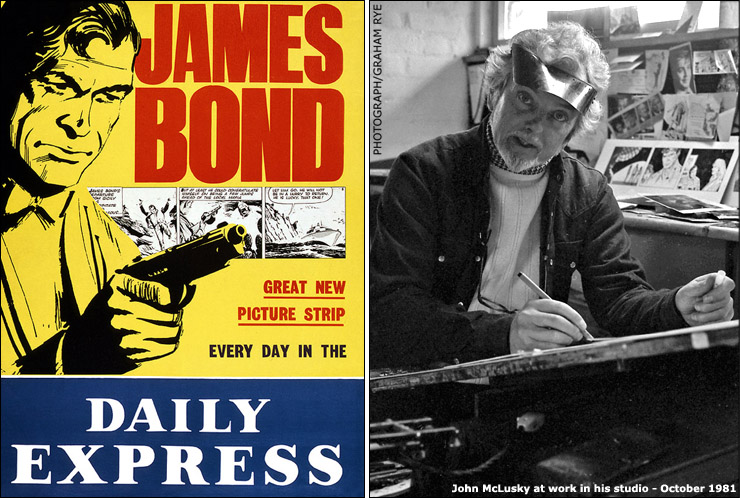 |
|
ON HER MAJESTY'S SECRET
SERVICE by Ian Fleming adapted
by Henry Gammidge
Monday June 29, 1964 to Monday May 17, 1965 - Strip #1-#274 (46-weeks)* |
|
 |
|
*ON HER
MAJESTY'S SECRET SERVICE included an additional strip #248A [pictured
below]
printed only in the Scottish Daily Express on Good Friday April 16,
1965. This unique single panel strip did not appear in any later
syndicated versions of the story, and adds nothing to the narrative other
than briefly extending Bond's escape from Piz Gloria. The story resumed in
the English Daily Express on Saturday April 17, 1965 with strip
#249. |
 |
|
YOU ONLY LIVE TWICE
by Ian Fleming adapted by
Henry Gammidge
Tuesday May 18, 1965 to Saturday January 8, 1966 - Strip #275-#475
(34-weeks) |
|
 |



















